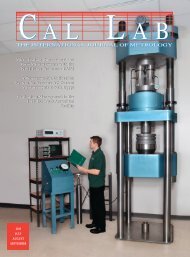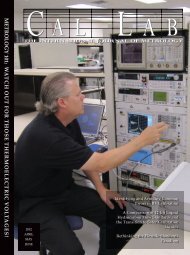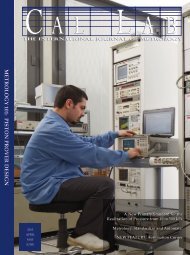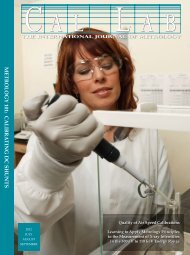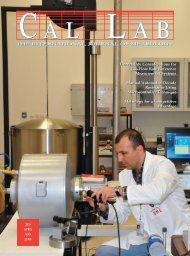Magazine – PDF - Cal Lab Magazine
Magazine – PDF - Cal Lab Magazine
Magazine – PDF - Cal Lab Magazine
Create successful ePaper yourself
Turn your PDF publications into a flip-book with our unique Google optimized e-Paper software.
Stating Best Uncertainties Over a Range of ValuesDavid Deaver2.1 <strong>Lab</strong>oratory 1: ExhaustiveAnalysis at Every PointThis laboratory decided to analyzethe uncertainties at many frequencypoints. Their CMC values are statedon their scope of accreditation asshown in Table 1. If the lab wantsto report other frequencies, theymust interpolate the uncertainties.These CMC values are plotted inFigure 1. Lines interconnect the pointsassuming the lab is authorized tolinearly interpolate between thepoints.2.2 <strong>Lab</strong>oratory 2: Analysis atFull Scale and Minimum Scale<strong>Lab</strong>oratory 2 decided that it wouldanalyze a full scale (1 MHz) and aminimum scale point (10 Hz). Theresults of the analysis are shown inTable 2.FrequencyUncertainty (μV/V)10 Hz 180Table 2. Measurement uncertainties for 2Vat 10Hz and 1 MHz.<strong>Lab</strong>oratory 2 then picked the largerof the two nearly equal uncertaintiesto state their CMC over the entirerange of frequencies for their Scopeof Accreditation:AC Voltage Measure at 2 V,10 Hz to 1 MHz: 180 μV/VThis value is plotted in Figure 1.A comparison of these first two labsshows <strong>Lab</strong>oratory 2 is overstating itsuncertainties by a huge amount overmost of the frequency range. However,even if <strong>Lab</strong>oratory 2 had performeda more rigorous analysis, it may stillhave decided to state its CMC at180 μV/V over the entire frequencyrange. It may have determined it didnot have a requirement for tighteruncertainties and desired to have avery simple CMC statement for itsScope of Accreditation. This examplealso points out the huge risk ofunderstating uncertainties if analysesare only conducted at the minimumand maximum values of the range.If the uncertainty values had beenmuch greater at points other than theend points, the lab could have beenmisrepresenting its CMC by using aconstant value throughout the range.2.3 <strong>Lab</strong>oratory 3: Analysisfor a Few Sub-RangesNow consider <strong>Lab</strong>oratory 3 whichperforms a rigorous uncertaintyanalysis like <strong>Lab</strong>oratory 1 but wouldlike to have a simpler statement ofthe CMC values. It decides to breakup the range into 4 regions and then,like <strong>Lab</strong>oratory 2, assign a CMC valuewhich is at least as large as all theuncertainty values calculated for therange. These CMC values are shownin Table 3 and Figure 1.CMC (uV/V)200180160140120100806040Figure 1.FrequencyFrequency (F)CMC (μV/V)10-50 Hz 18050-5000 Hz 505-20k Hz 10020 kHz -1 MHz 1801 MHz 175 Table 3. CMC values for <strong>Lab</strong>oratory 3.<strong>Lab</strong> 2<strong>Lab</strong> 3 <strong>Lab</strong> 4<strong>Lab</strong>oratory 3 has a much simplertable of CMC values than <strong>Lab</strong>oratory1 but it can be seen that the CMCvalues are not optimized for all ofthe sub-ranges. However, if thelaboratory’s main need is to havelow CMC values from 50 Hz to 5kHz, this may be a very reasonableapproach.2.4 <strong>Lab</strong>oratory 4: ModelingEquations<strong>Lab</strong>oratory 4 demonstrates thebenefits of developing a good modelfor the behavior of the uncertaintiesvs. frequency. By performing abit more analysis of the data than<strong>Lab</strong>oratory 1, it is able to curve fitthe uncertainties into two regions.The equations for the CMC values donot understate the capabilities of thelaboratory but still allow the lab’scapabilities to be stated in a compactmanner in Table 4. These equationsare plotted in Figure 1.CMC (μV/V)(F = Frequency in Hz)340 ) 10 Hz to 50 Hz 40 + 140 · ( ___ 50−F__50 Hz to 1 MHz 40 + 0.135 · √ F Table 4. <strong>Lab</strong>oratory 4 CMC values for 2 V AC <strong>–</strong> Measure from 10 Hz to 1 MHz.<strong>Lab</strong> 120Frequency (Hz)010 100 1000 10000 100000 1000000Summary of 4 methods of stating CMCs over a range of values.Jan • Feb • Mar 201325<strong>Cal</strong> <strong>Lab</strong>: The International Journal of Metrology



